Individual Assessment: QUT Public Health Hypertension Study Analysis
VerifiedAdded on 2022/10/13
|9
|2804
|347
Homework Assignment
AI Summary
This assignment presents a comprehensive assessment of a quantitative study focusing on hypertension, likely examining the relationship between physical activity and the reduction of hypertension. The student meticulously evaluates the study's design, including randomization methods and potential biases, and assesses the selection of participants, the validity and reliability of data collection tools, and the handling of withdrawals and drop-outs. The analysis also delves into intervention integrity, statistical methods, and the overall clinical meaningfulness of the study's findings. The student's evaluation culminates in an overall conclusion about the study's trustworthiness, implications for practice, and a discussion of any discrepancies encountered during peer review, reflecting a thorough understanding of epidemiological principles and research methodology. The assignment follows a structured format, including a PICO question, component ratings, and a global rating, demonstrating a strong grasp of the subject matter.
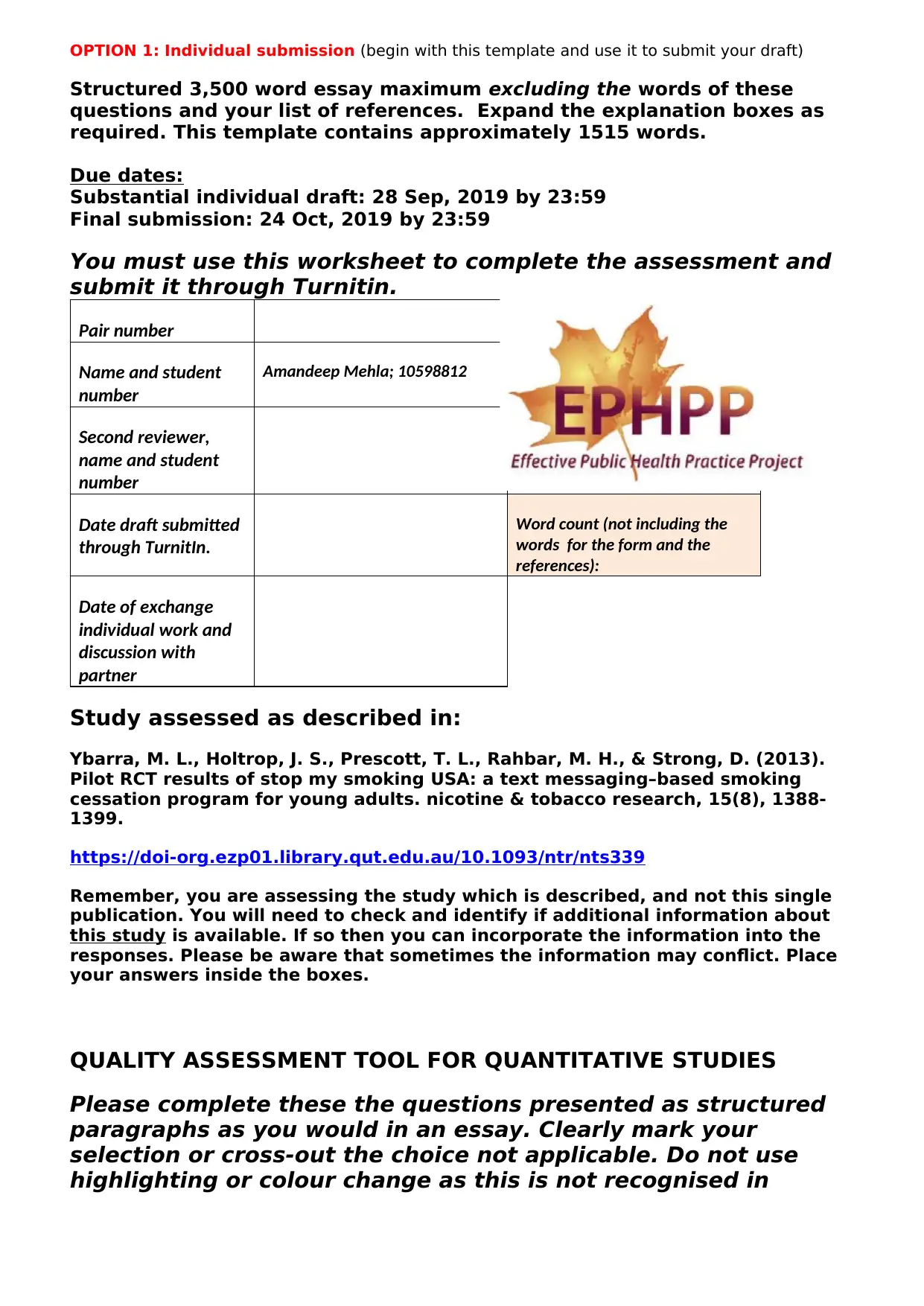
OPTION 1: Individual submission (begin with this template and use it to submit your draft)
Structured 3,500 word essay maximum excluding the words of these
questions and your list of references. Expand the explanation boxes as
required. This template contains approximately 1515 words.
Due dates:
Substantial individual draft: 28 Sep, 2019 by 23:59
Final submission: 24 Oct, 2019 by 23:59
You must use this worksheet to complete the assessment and
submit it through Turnitin.
Pair number
Name and student
number
Amandeep Mehla; 10598812
Second reviewer,
name and student
number
Date draft submitted
through TurnitIn.
Word count (not including the
words for the form and the
references):
Date of exchange
individual work and
discussion with
partner
Study assessed as described in:
Ybarra, M. L., Holtrop, J. S., Prescott, T. L., Rahbar, M. H., & Strong, D. (2013).
Pilot RCT results of stop my smoking USA: a text messaging–based smoking
cessation program for young adults. nicotine & tobacco research, 15(8), 1388-
1399.
https://doi-org.ezp01.library.qut.edu.au/10.1093/ntr/nts339
Remember, you are assessing the study which is described, and not this single
publication. You will need to check and identify if additional information about
this study is available. If so then you can incorporate the information into the
responses. Please be aware that sometimes the information may conflict. Place
your answers inside the boxes.
QUALITY ASSESSMENT TOOL FOR QUANTITATIVE STUDIES
Please complete these the questions presented as structured
paragraphs as you would in an essay. Clearly mark your
selection or cross-out the choice not applicable. Do not use
highlighting or colour change as this is not recognised in
Structured 3,500 word essay maximum excluding the words of these
questions and your list of references. Expand the explanation boxes as
required. This template contains approximately 1515 words.
Due dates:
Substantial individual draft: 28 Sep, 2019 by 23:59
Final submission: 24 Oct, 2019 by 23:59
You must use this worksheet to complete the assessment and
submit it through Turnitin.
Pair number
Name and student
number
Amandeep Mehla; 10598812
Second reviewer,
name and student
number
Date draft submitted
through TurnitIn.
Word count (not including the
words for the form and the
references):
Date of exchange
individual work and
discussion with
partner
Study assessed as described in:
Ybarra, M. L., Holtrop, J. S., Prescott, T. L., Rahbar, M. H., & Strong, D. (2013).
Pilot RCT results of stop my smoking USA: a text messaging–based smoking
cessation program for young adults. nicotine & tobacco research, 15(8), 1388-
1399.
https://doi-org.ezp01.library.qut.edu.au/10.1093/ntr/nts339
Remember, you are assessing the study which is described, and not this single
publication. You will need to check and identify if additional information about
this study is available. If so then you can incorporate the information into the
responses. Please be aware that sometimes the information may conflict. Place
your answers inside the boxes.
QUALITY ASSESSMENT TOOL FOR QUANTITATIVE STUDIES
Please complete these the questions presented as structured
paragraphs as you would in an essay. Clearly mark your
selection or cross-out the choice not applicable. Do not use
highlighting or colour change as this is not recognised in
Paraphrase This Document
Need a fresh take? Get an instant paraphrase of this document with our AI Paraphraser
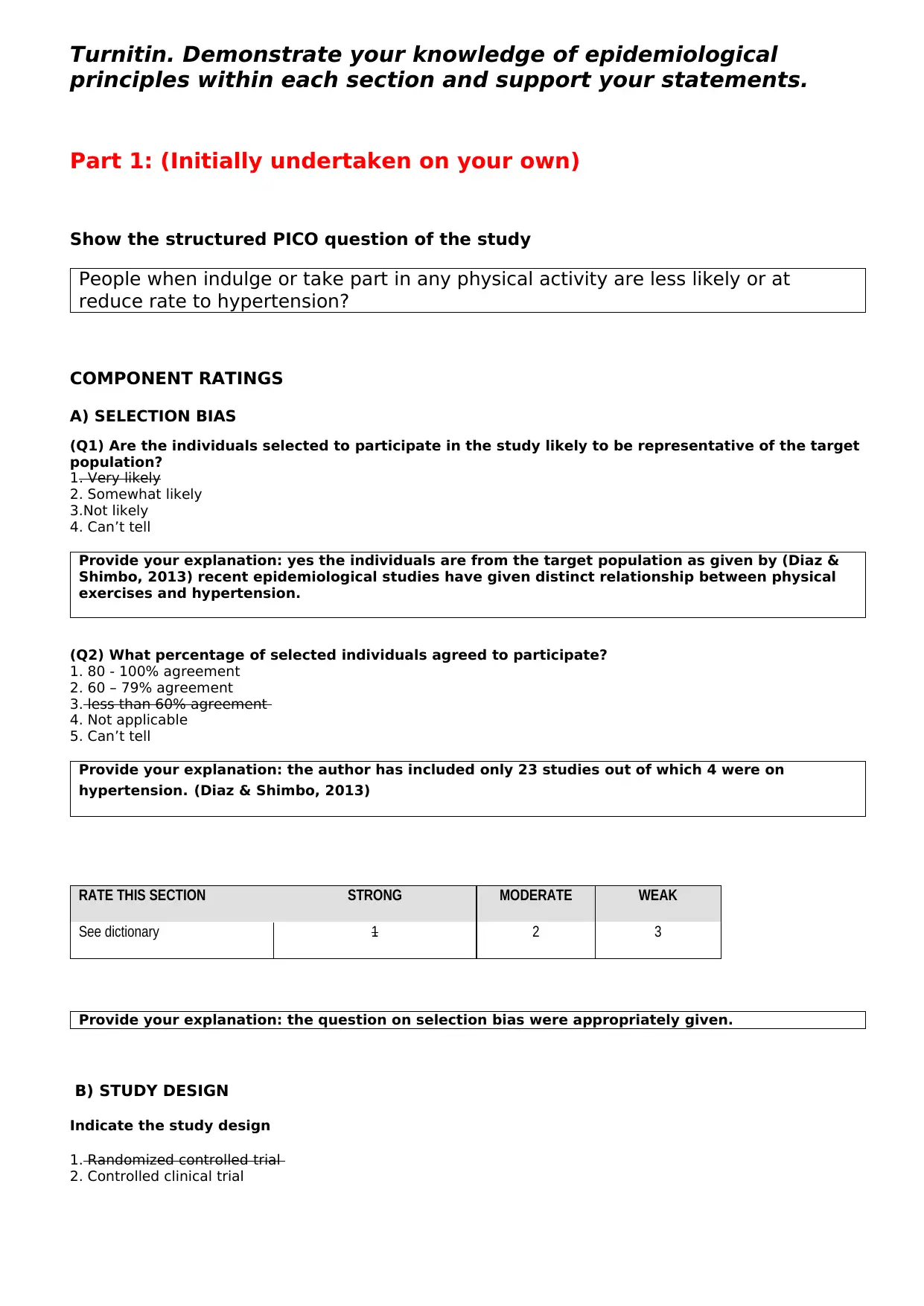
Turnitin. Demonstrate your knowledge of epidemiological
principles within each section and support your statements.
Part 1: (Initially undertaken on your own)
Show the structured PICO question of the study
People when indulge or take part in any physical activity are less likely or at
reduce rate to hypertension?
COMPONENT RATINGS
A) SELECTION BIAS
(Q1) Are the individuals selected to participate in the study likely to be representative of the target
population?
1. Very likely
2. Somewhat likely
3.Not likely
4. Can’t tell
Provide your explanation: yes the individuals are from the target population as given by (Diaz &
Shimbo, 2013) recent epidemiological studies have given distinct relationship between physical
exercises and hypertension.
(Q2) What percentage of selected individuals agreed to participate?
1. 80 - 100% agreement
2. 60 – 79% agreement
3. less than 60% agreement
4. Not applicable
5. Can’t tell
Provide your explanation: the author has included only 23 studies out of which 4 were on
hypertension. (Diaz & Shimbo, 2013)
RATE THIS SECTION STRONG MODERATE WEAK
See dictionary 1 2 3
Provide your explanation: the question on selection bias were appropriately given.
B) STUDY DESIGN
Indicate the study design
1. Randomized controlled trial
2. Controlled clinical trial
principles within each section and support your statements.
Part 1: (Initially undertaken on your own)
Show the structured PICO question of the study
People when indulge or take part in any physical activity are less likely or at
reduce rate to hypertension?
COMPONENT RATINGS
A) SELECTION BIAS
(Q1) Are the individuals selected to participate in the study likely to be representative of the target
population?
1. Very likely
2. Somewhat likely
3.Not likely
4. Can’t tell
Provide your explanation: yes the individuals are from the target population as given by (Diaz &
Shimbo, 2013) recent epidemiological studies have given distinct relationship between physical
exercises and hypertension.
(Q2) What percentage of selected individuals agreed to participate?
1. 80 - 100% agreement
2. 60 – 79% agreement
3. less than 60% agreement
4. Not applicable
5. Can’t tell
Provide your explanation: the author has included only 23 studies out of which 4 were on
hypertension. (Diaz & Shimbo, 2013)
RATE THIS SECTION STRONG MODERATE WEAK
See dictionary 1 2 3
Provide your explanation: the question on selection bias were appropriately given.
B) STUDY DESIGN
Indicate the study design
1. Randomized controlled trial
2. Controlled clinical trial
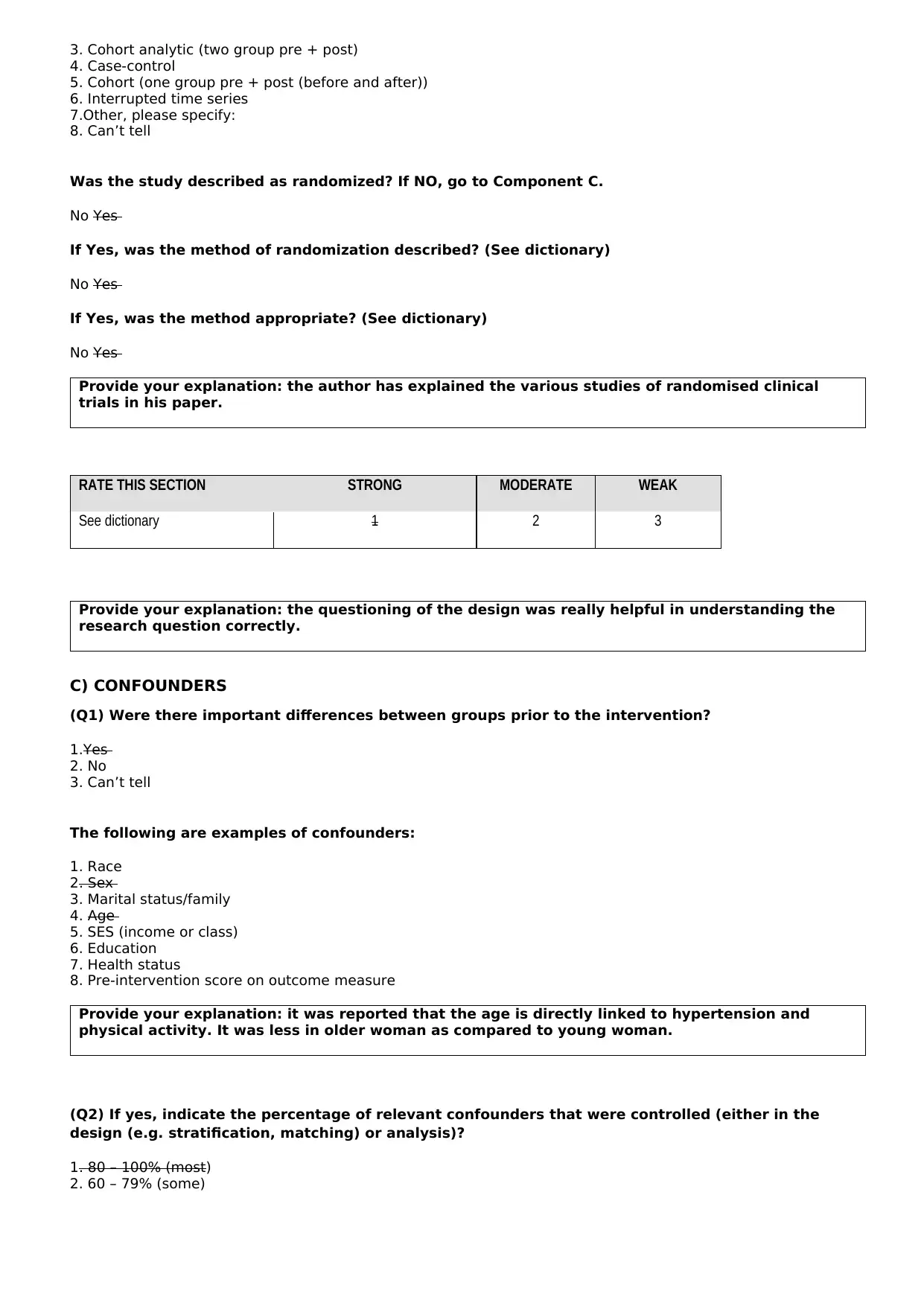
3. Cohort analytic (two group pre + post)
4. Case-control
5. Cohort (one group pre + post (before and after))
6. Interrupted time series
7.Other, please specify:
8. Can’t tell
Was the study described as randomized? If NO, go to Component C.
No Yes
If Yes, was the method of randomization described? (See dictionary)
No Yes
If Yes, was the method appropriate? (See dictionary)
No Yes
Provide your explanation: the author has explained the various studies of randomised clinical
trials in his paper.
RATE THIS SECTION STRONG MODERATE WEAK
See dictionary 1 2 3
Provide your explanation: the questioning of the design was really helpful in understanding the
research question correctly.
C) CONFOUNDERS
(Q1) Were there important differences between groups prior to the intervention?
1.Yes
2. No
3. Can’t tell
The following are examples of confounders:
1. Race
2. Sex
3. Marital status/family
4. Age
5. SES (income or class)
6. Education
7. Health status
8. Pre-intervention score on outcome measure
Provide your explanation: it was reported that the age is directly linked to hypertension and
physical activity. It was less in older woman as compared to young woman.
(Q2) If yes, indicate the percentage of relevant confounders that were controlled (either in the
design (e.g. stratification, matching) or analysis)?
1. 80 – 100% (most)
2. 60 – 79% (some)
4. Case-control
5. Cohort (one group pre + post (before and after))
6. Interrupted time series
7.Other, please specify:
8. Can’t tell
Was the study described as randomized? If NO, go to Component C.
No Yes
If Yes, was the method of randomization described? (See dictionary)
No Yes
If Yes, was the method appropriate? (See dictionary)
No Yes
Provide your explanation: the author has explained the various studies of randomised clinical
trials in his paper.
RATE THIS SECTION STRONG MODERATE WEAK
See dictionary 1 2 3
Provide your explanation: the questioning of the design was really helpful in understanding the
research question correctly.
C) CONFOUNDERS
(Q1) Were there important differences between groups prior to the intervention?
1.Yes
2. No
3. Can’t tell
The following are examples of confounders:
1. Race
2. Sex
3. Marital status/family
4. Age
5. SES (income or class)
6. Education
7. Health status
8. Pre-intervention score on outcome measure
Provide your explanation: it was reported that the age is directly linked to hypertension and
physical activity. It was less in older woman as compared to young woman.
(Q2) If yes, indicate the percentage of relevant confounders that were controlled (either in the
design (e.g. stratification, matching) or analysis)?
1. 80 – 100% (most)
2. 60 – 79% (some)
⊘ This is a preview!⊘
Do you want full access?
Subscribe today to unlock all pages.

Trusted by 1+ million students worldwide
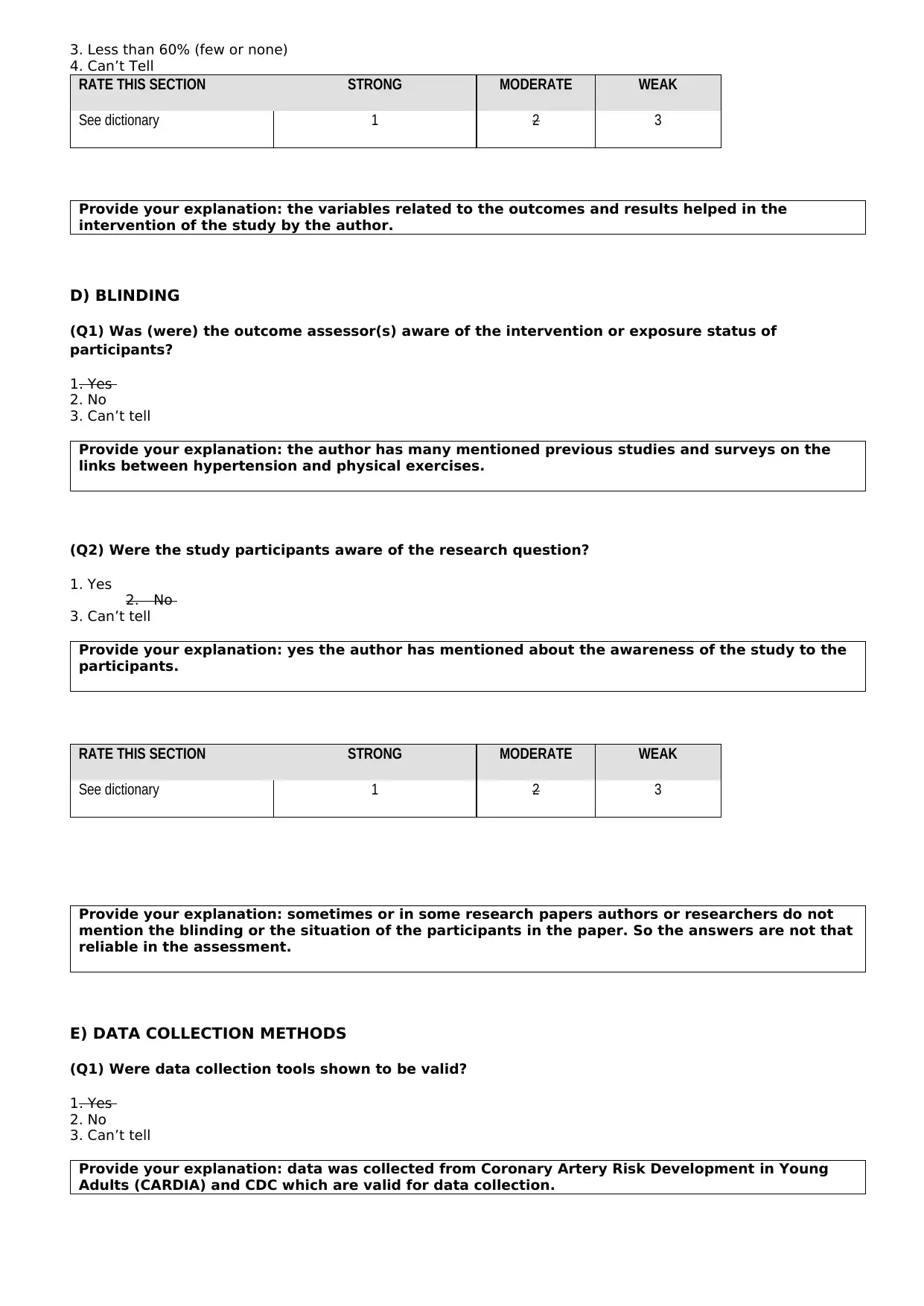
3. Less than 60% (few or none)
4. Can’t Tell
RATE THIS SECTION STRONG MODERATE WEAK
See dictionary 1 2 3
Provide your explanation: the variables related to the outcomes and results helped in the
intervention of the study by the author.
D) BLINDING
(Q1) Was (were) the outcome assessor(s) aware of the intervention or exposure status of
participants?
1. Yes
2. No
3. Can’t tell
Provide your explanation: the author has many mentioned previous studies and surveys on the
links between hypertension and physical exercises.
(Q2) Were the study participants aware of the research question?
1. Yes
2. No
3. Can’t tell
Provide your explanation: yes the author has mentioned about the awareness of the study to the
participants.
RATE THIS SECTION STRONG MODERATE WEAK
See dictionary 1 2 3
Provide your explanation: sometimes or in some research papers authors or researchers do not
mention the blinding or the situation of the participants in the paper. So the answers are not that
reliable in the assessment.
E) DATA COLLECTION METHODS
(Q1) Were data collection tools shown to be valid?
1. Yes
2. No
3. Can’t tell
Provide your explanation: data was collected from Coronary Artery Risk Development in Young
Adults (CARDIA) and CDC which are valid for data collection.
4. Can’t Tell
RATE THIS SECTION STRONG MODERATE WEAK
See dictionary 1 2 3
Provide your explanation: the variables related to the outcomes and results helped in the
intervention of the study by the author.
D) BLINDING
(Q1) Was (were) the outcome assessor(s) aware of the intervention or exposure status of
participants?
1. Yes
2. No
3. Can’t tell
Provide your explanation: the author has many mentioned previous studies and surveys on the
links between hypertension and physical exercises.
(Q2) Were the study participants aware of the research question?
1. Yes
2. No
3. Can’t tell
Provide your explanation: yes the author has mentioned about the awareness of the study to the
participants.
RATE THIS SECTION STRONG MODERATE WEAK
See dictionary 1 2 3
Provide your explanation: sometimes or in some research papers authors or researchers do not
mention the blinding or the situation of the participants in the paper. So the answers are not that
reliable in the assessment.
E) DATA COLLECTION METHODS
(Q1) Were data collection tools shown to be valid?
1. Yes
2. No
3. Can’t tell
Provide your explanation: data was collected from Coronary Artery Risk Development in Young
Adults (CARDIA) and CDC which are valid for data collection.
Paraphrase This Document
Need a fresh take? Get an instant paraphrase of this document with our AI Paraphraser
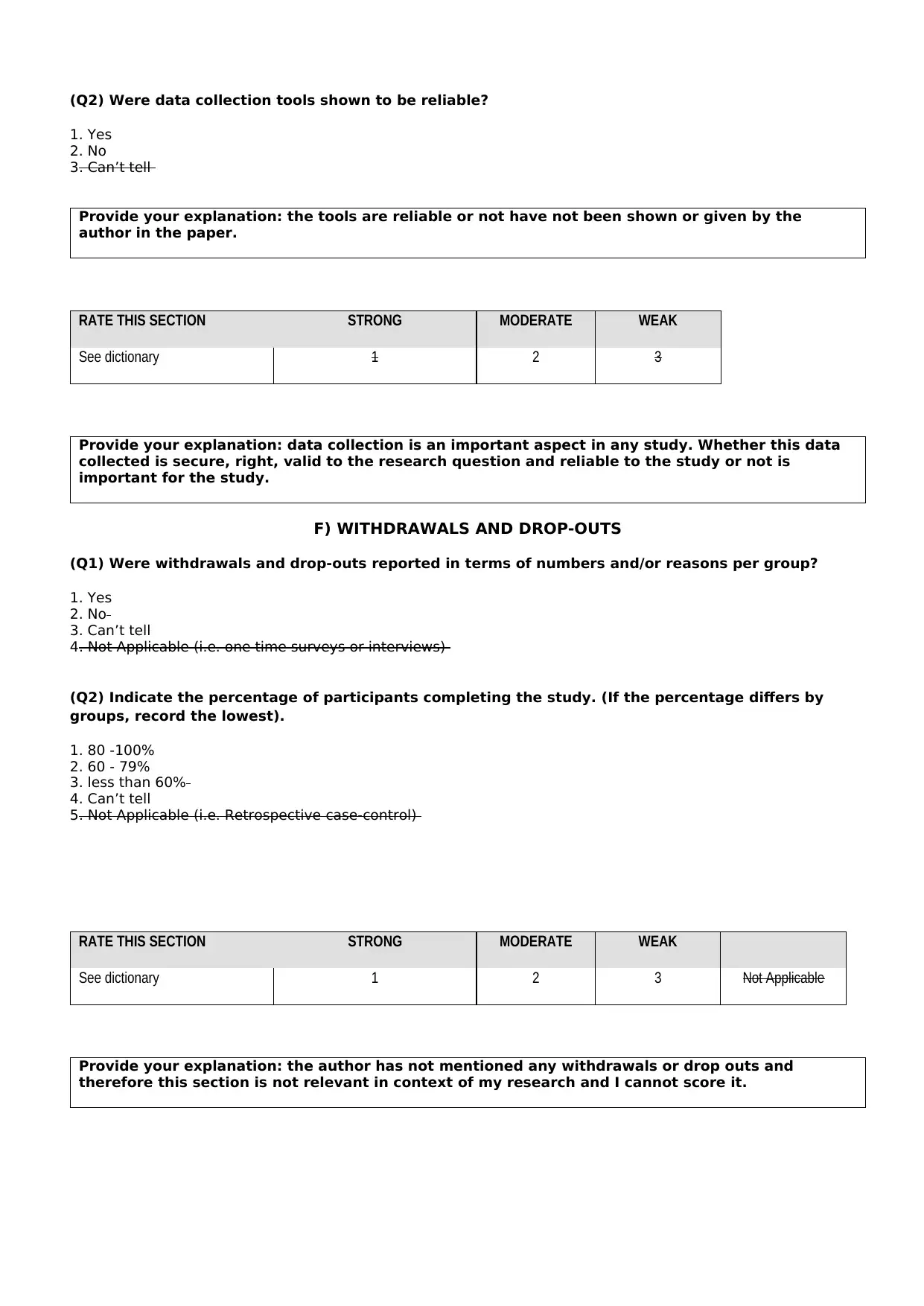
(Q2) Were data collection tools shown to be reliable?
1. Yes
2. No
3. Can’t tell
Provide your explanation: the tools are reliable or not have not been shown or given by the
author in the paper.
RATE THIS SECTION STRONG MODERATE WEAK
See dictionary 1 2 3
Provide your explanation: data collection is an important aspect in any study. Whether this data
collected is secure, right, valid to the research question and reliable to the study or not is
important for the study.
F) WITHDRAWALS AND DROP-OUTS
(Q1) Were withdrawals and drop-outs reported in terms of numbers and/or reasons per group?
1. Yes
2. No
3. Can’t tell
4. Not Applicable (i.e. one time surveys or interviews)
(Q2) Indicate the percentage of participants completing the study. (If the percentage differs by
groups, record the lowest).
1. 80 -100%
2. 60 - 79%
3. less than 60%
4. Can’t tell
5. Not Applicable (i.e. Retrospective case-control)
RATE THIS SECTION STRONG MODERATE WEAK
See dictionary 1 2 3 Not Applicable
Provide your explanation: the author has not mentioned any withdrawals or drop outs and
therefore this section is not relevant in context of my research and I cannot score it.
1. Yes
2. No
3. Can’t tell
Provide your explanation: the tools are reliable or not have not been shown or given by the
author in the paper.
RATE THIS SECTION STRONG MODERATE WEAK
See dictionary 1 2 3
Provide your explanation: data collection is an important aspect in any study. Whether this data
collected is secure, right, valid to the research question and reliable to the study or not is
important for the study.
F) WITHDRAWALS AND DROP-OUTS
(Q1) Were withdrawals and drop-outs reported in terms of numbers and/or reasons per group?
1. Yes
2. No
3. Can’t tell
4. Not Applicable (i.e. one time surveys or interviews)
(Q2) Indicate the percentage of participants completing the study. (If the percentage differs by
groups, record the lowest).
1. 80 -100%
2. 60 - 79%
3. less than 60%
4. Can’t tell
5. Not Applicable (i.e. Retrospective case-control)
RATE THIS SECTION STRONG MODERATE WEAK
See dictionary 1 2 3 Not Applicable
Provide your explanation: the author has not mentioned any withdrawals or drop outs and
therefore this section is not relevant in context of my research and I cannot score it.
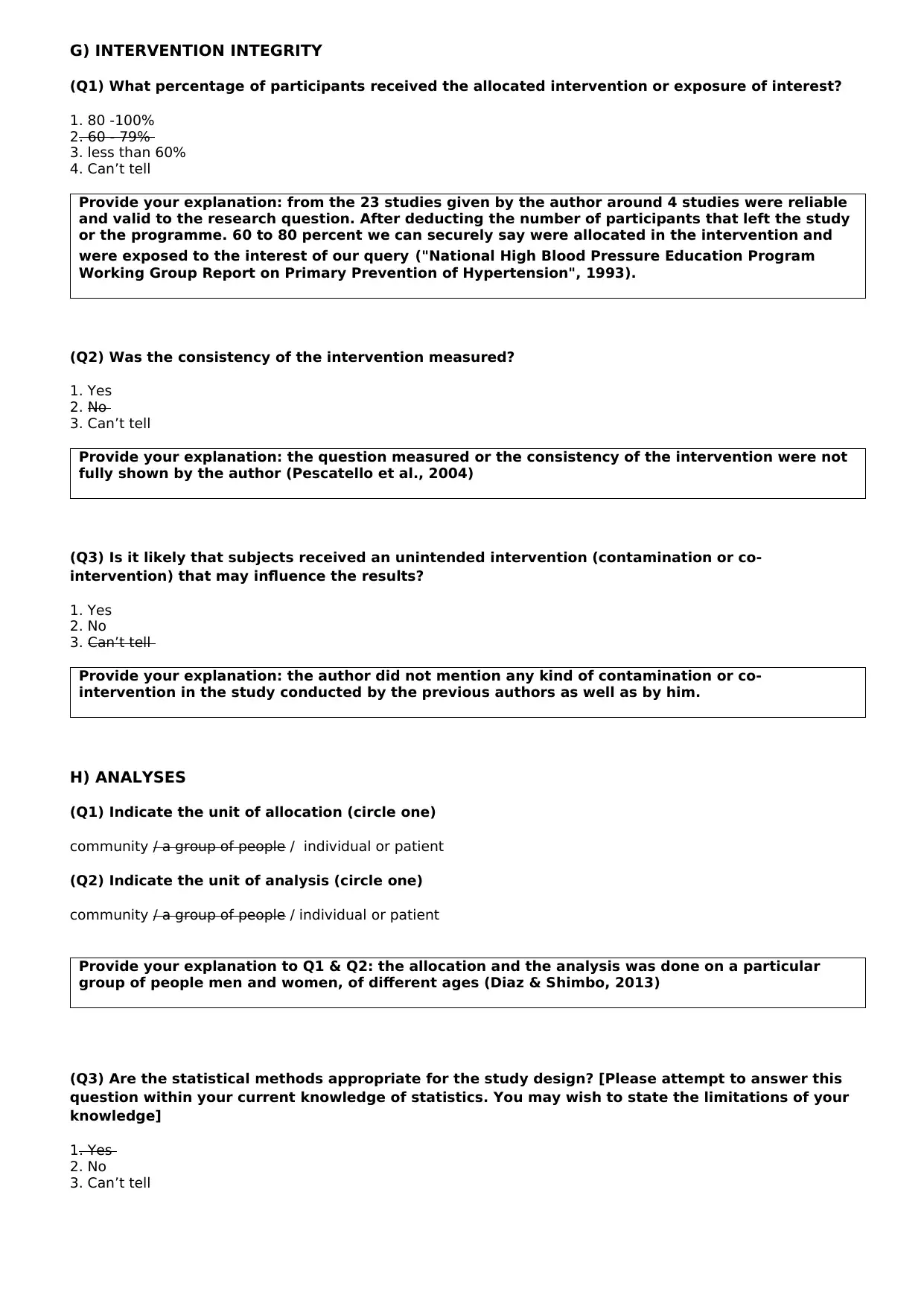
G) INTERVENTION INTEGRITY
(Q1) What percentage of participants received the allocated intervention or exposure of interest?
1. 80 -100%
2. 60 - 79%
3. less than 60%
4. Can’t tell
Provide your explanation: from the 23 studies given by the author around 4 studies were reliable
and valid to the research question. After deducting the number of participants that left the study
or the programme. 60 to 80 percent we can securely say were allocated in the intervention and
were exposed to the interest of our query ("National High Blood Pressure Education Program
Working Group Report on Primary Prevention of Hypertension", 1993).
(Q2) Was the consistency of the intervention measured?
1. Yes
2. No
3. Can’t tell
Provide your explanation: the question measured or the consistency of the intervention were not
fully shown by the author (Pescatello et al., 2004)
(Q3) Is it likely that subjects received an unintended intervention (contamination or co-
intervention) that may influence the results?
1. Yes
2. No
3. Can’t tell
Provide your explanation: the author did not mention any kind of contamination or co-
intervention in the study conducted by the previous authors as well as by him.
H) ANALYSES
(Q1) Indicate the unit of allocation (circle one)
community / a group of people / individual or patient
(Q2) Indicate the unit of analysis (circle one)
community / a group of people / individual or patient
Provide your explanation to Q1 & Q2: the allocation and the analysis was done on a particular
group of people men and women, of different ages (Diaz & Shimbo, 2013)
(Q3) Are the statistical methods appropriate for the study design? [Please attempt to answer this
question within your current knowledge of statistics. You may wish to state the limitations of your
knowledge]
1. Yes
2. No
3. Can’t tell
(Q1) What percentage of participants received the allocated intervention or exposure of interest?
1. 80 -100%
2. 60 - 79%
3. less than 60%
4. Can’t tell
Provide your explanation: from the 23 studies given by the author around 4 studies were reliable
and valid to the research question. After deducting the number of participants that left the study
or the programme. 60 to 80 percent we can securely say were allocated in the intervention and
were exposed to the interest of our query ("National High Blood Pressure Education Program
Working Group Report on Primary Prevention of Hypertension", 1993).
(Q2) Was the consistency of the intervention measured?
1. Yes
2. No
3. Can’t tell
Provide your explanation: the question measured or the consistency of the intervention were not
fully shown by the author (Pescatello et al., 2004)
(Q3) Is it likely that subjects received an unintended intervention (contamination or co-
intervention) that may influence the results?
1. Yes
2. No
3. Can’t tell
Provide your explanation: the author did not mention any kind of contamination or co-
intervention in the study conducted by the previous authors as well as by him.
H) ANALYSES
(Q1) Indicate the unit of allocation (circle one)
community / a group of people / individual or patient
(Q2) Indicate the unit of analysis (circle one)
community / a group of people / individual or patient
Provide your explanation to Q1 & Q2: the allocation and the analysis was done on a particular
group of people men and women, of different ages (Diaz & Shimbo, 2013)
(Q3) Are the statistical methods appropriate for the study design? [Please attempt to answer this
question within your current knowledge of statistics. You may wish to state the limitations of your
knowledge]
1. Yes
2. No
3. Can’t tell
⊘ This is a preview!⊘
Do you want full access?
Subscribe today to unlock all pages.

Trusted by 1+ million students worldwide

Provide your explanation: the statistical methods used such as random sampling and the
selection of the sample size were appropriate by the author. There may have been some errors in
the data collection and the reliability of the data by the author.
(Q4) Is the analysis performed by intervention allocation status (i.e. intention to treat) rather than
the actual intervention received?
1. Yes
2. No
3. Can’t tell
Provide your explanation: yes the intervention was allocated in treating the disease as given in
(Forman, 2009) in comparing the rate of hypertension in women of different age, there were
result of younger women who do exercises are less likely to get hypertension where the opposite
in the older woman.
GLOBAL RATING
COMPONENT RATINGS
Please transcribe the information from the grey boxes on pages 1-4 onto this page. See dictionary on how to rate
this section.
A SELECTION BIAS STRONG MODERATE WEAK
1 2 3
B STUDY DESIGN STRONG MODERATE WEAK
1 2 3
C CONFOUNDERS STRONG MODERATE WEAK
1 2 3
D BLINDING STRONG MODERATE WEAK
1 2 3
E DATA COLLECTION METHOD STRONG MODERATE WEAK
1 2 3
F WITHDRAWALS AND
DROPOUTS
STRONG MODERATE WEAK
1 2 3 Not Applicable
CIISA.Me81288
GLOBAL RATING FOR THIS PAPER (circle one):
1 STRONG (no WEAK ratings)
2 MODERATE (one WEAK rating)
3 WEAK (two or more WEAK ratings)
selection of the sample size were appropriate by the author. There may have been some errors in
the data collection and the reliability of the data by the author.
(Q4) Is the analysis performed by intervention allocation status (i.e. intention to treat) rather than
the actual intervention received?
1. Yes
2. No
3. Can’t tell
Provide your explanation: yes the intervention was allocated in treating the disease as given in
(Forman, 2009) in comparing the rate of hypertension in women of different age, there were
result of younger women who do exercises are less likely to get hypertension where the opposite
in the older woman.
GLOBAL RATING
COMPONENT RATINGS
Please transcribe the information from the grey boxes on pages 1-4 onto this page. See dictionary on how to rate
this section.
A SELECTION BIAS STRONG MODERATE WEAK
1 2 3
B STUDY DESIGN STRONG MODERATE WEAK
1 2 3
C CONFOUNDERS STRONG MODERATE WEAK
1 2 3
D BLINDING STRONG MODERATE WEAK
1 2 3
E DATA COLLECTION METHOD STRONG MODERATE WEAK
1 2 3
F WITHDRAWALS AND
DROPOUTS
STRONG MODERATE WEAK
1 2 3 Not Applicable
CIISA.Me81288
GLOBAL RATING FOR THIS PAPER (circle one):
1 STRONG (no WEAK ratings)
2 MODERATE (one WEAK rating)
3 WEAK (two or more WEAK ratings)
Paraphrase This Document
Need a fresh take? Get an instant paraphrase of this document with our AI Paraphraser
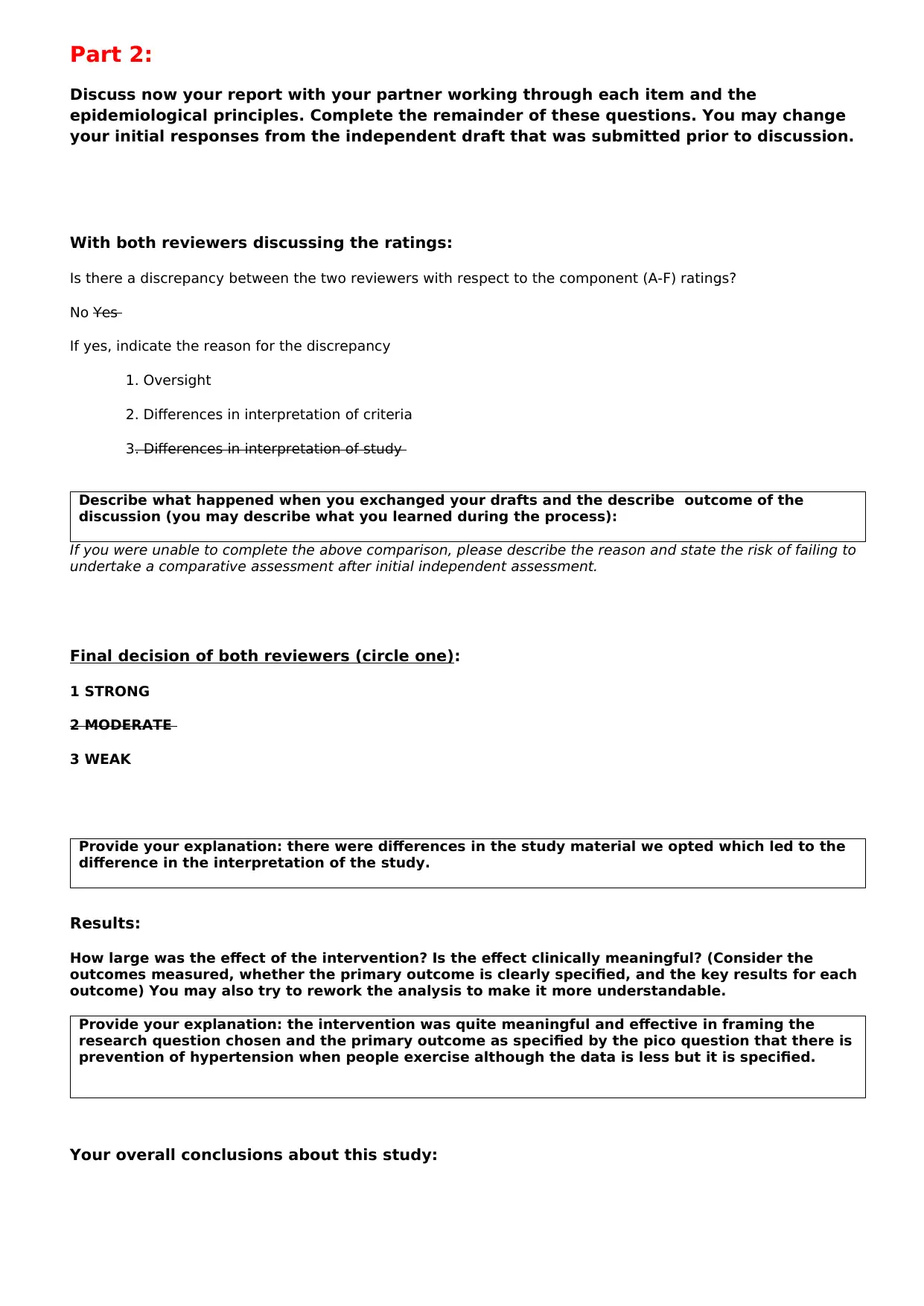
Part 2:
Discuss now your report with your partner working through each item and the
epidemiological principles. Complete the remainder of these questions. You may change
your initial responses from the independent draft that was submitted prior to discussion.
With both reviewers discussing the ratings:
Is there a discrepancy between the two reviewers with respect to the component (A-F) ratings?
No Yes
If yes, indicate the reason for the discrepancy
1. Oversight
2. Differences in interpretation of criteria
3. Differences in interpretation of study
Describe what happened when you exchanged your drafts and the describe outcome of the
discussion (you may describe what you learned during the process):
If you were unable to complete the above comparison, please describe the reason and state the risk of failing to
undertake a comparative assessment after initial independent assessment.
Final decision of both reviewers (circle one):
1 STRONG
2 MODERATE
3 WEAK
Provide your explanation: there were differences in the study material we opted which led to the
difference in the interpretation of the study.
Results:
How large was the effect of the intervention? Is the effect clinically meaningful? (Consider the
outcomes measured, whether the primary outcome is clearly specified, and the key results for each
outcome) You may also try to rework the analysis to make it more understandable.
Provide your explanation: the intervention was quite meaningful and effective in framing the
research question chosen and the primary outcome as specified by the pico question that there is
prevention of hypertension when people exercise although the data is less but it is specified.
Your overall conclusions about this study:
Discuss now your report with your partner working through each item and the
epidemiological principles. Complete the remainder of these questions. You may change
your initial responses from the independent draft that was submitted prior to discussion.
With both reviewers discussing the ratings:
Is there a discrepancy between the two reviewers with respect to the component (A-F) ratings?
No Yes
If yes, indicate the reason for the discrepancy
1. Oversight
2. Differences in interpretation of criteria
3. Differences in interpretation of study
Describe what happened when you exchanged your drafts and the describe outcome of the
discussion (you may describe what you learned during the process):
If you were unable to complete the above comparison, please describe the reason and state the risk of failing to
undertake a comparative assessment after initial independent assessment.
Final decision of both reviewers (circle one):
1 STRONG
2 MODERATE
3 WEAK
Provide your explanation: there were differences in the study material we opted which led to the
difference in the interpretation of the study.
Results:
How large was the effect of the intervention? Is the effect clinically meaningful? (Consider the
outcomes measured, whether the primary outcome is clearly specified, and the key results for each
outcome) You may also try to rework the analysis to make it more understandable.
Provide your explanation: the intervention was quite meaningful and effective in framing the
research question chosen and the primary outcome as specified by the pico question that there is
prevention of hypertension when people exercise although the data is less but it is specified.
Your overall conclusions about this study:
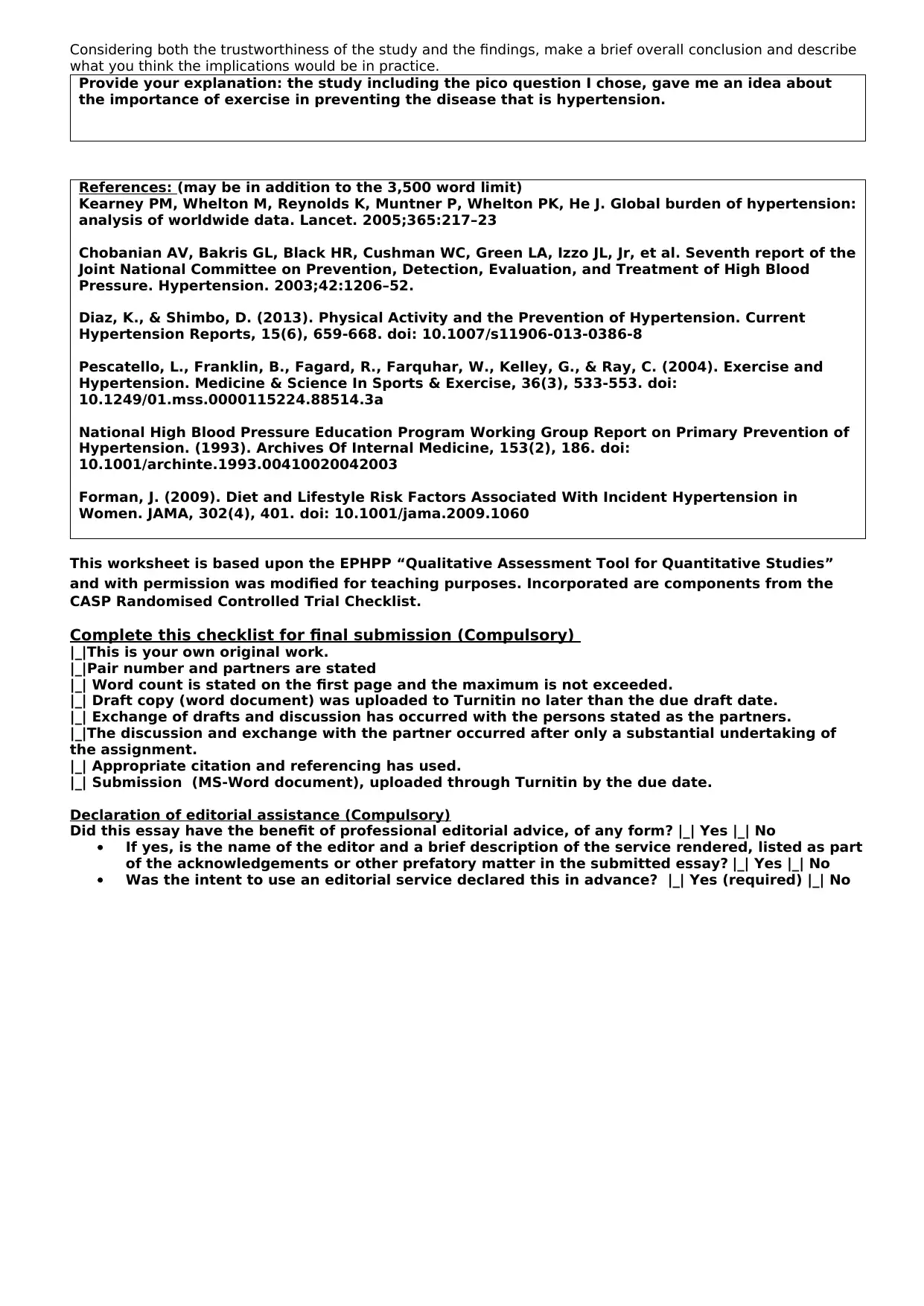
Considering both the trustworthiness of the study and the findings, make a brief overall conclusion and describe
what you think the implications would be in practice.
Provide your explanation: the study including the pico question I chose, gave me an idea about
the importance of exercise in preventing the disease that is hypertension.
References: (may be in addition to the 3,500 word limit)
Kearney PM, Whelton M, Reynolds K, Muntner P, Whelton PK, He J. Global burden of hypertension:
analysis of worldwide data. Lancet. 2005;365:217–23
Chobanian AV, Bakris GL, Black HR, Cushman WC, Green LA, Izzo JL, Jr, et al. Seventh report of the
Joint National Committee on Prevention, Detection, Evaluation, and Treatment of High Blood
Pressure. Hypertension. 2003;42:1206–52.
Diaz, K., & Shimbo, D. (2013). Physical Activity and the Prevention of Hypertension. Current
Hypertension Reports, 15(6), 659-668. doi: 10.1007/s11906-013-0386-8
Pescatello, L., Franklin, B., Fagard, R., Farquhar, W., Kelley, G., & Ray, C. (2004). Exercise and
Hypertension. Medicine & Science In Sports & Exercise, 36(3), 533-553. doi:
10.1249/01.mss.0000115224.88514.3a
National High Blood Pressure Education Program Working Group Report on Primary Prevention of
Hypertension. (1993). Archives Of Internal Medicine, 153(2), 186. doi:
10.1001/archinte.1993.00410020042003
Forman, J. (2009). Diet and Lifestyle Risk Factors Associated With Incident Hypertension in
Women. JAMA, 302(4), 401. doi: 10.1001/jama.2009.1060
This worksheet is based upon the EPHPP “Qualitative Assessment Tool for Quantitative Studies”
and with permission was modified for teaching purposes. Incorporated are components from the
CASP Randomised Controlled Trial Checklist.
A.Me812
Complete this checklist for final submission (Compulsory)
|_|This is your own original work.
|_|Pair number and partners are stated
|_| Word count is stated on the first page and the maximum is not exceeded.
|_| Draft copy (word document) was uploaded to Turnitin no later than the due draft date.
|_| Exchange of drafts and discussion has occurred with the persons stated as the partners.
|_|The discussion and exchange with the partner occurred after only a substantial undertaking of
the assignment.
|_| Appropriate citation and referencing has used.
|_| Submission (MS-Word document), uploaded through Turnitin by the due date.
Declaration of editorial assistance (Compulsory)
Did this essay have the benefit of professional editorial advice, of any form? |_| Yes |_| No
If yes, is the name of the editor and a brief description of the service rendered, listed as part
of the acknowledgements or other prefatory matter in the submitted essay? |_| Yes |_| No
Was the intent to use an editorial service declared this in advance? |_| Yes (required) |_| No
what you think the implications would be in practice.
Provide your explanation: the study including the pico question I chose, gave me an idea about
the importance of exercise in preventing the disease that is hypertension.
References: (may be in addition to the 3,500 word limit)
Kearney PM, Whelton M, Reynolds K, Muntner P, Whelton PK, He J. Global burden of hypertension:
analysis of worldwide data. Lancet. 2005;365:217–23
Chobanian AV, Bakris GL, Black HR, Cushman WC, Green LA, Izzo JL, Jr, et al. Seventh report of the
Joint National Committee on Prevention, Detection, Evaluation, and Treatment of High Blood
Pressure. Hypertension. 2003;42:1206–52.
Diaz, K., & Shimbo, D. (2013). Physical Activity and the Prevention of Hypertension. Current
Hypertension Reports, 15(6), 659-668. doi: 10.1007/s11906-013-0386-8
Pescatello, L., Franklin, B., Fagard, R., Farquhar, W., Kelley, G., & Ray, C. (2004). Exercise and
Hypertension. Medicine & Science In Sports & Exercise, 36(3), 533-553. doi:
10.1249/01.mss.0000115224.88514.3a
National High Blood Pressure Education Program Working Group Report on Primary Prevention of
Hypertension. (1993). Archives Of Internal Medicine, 153(2), 186. doi:
10.1001/archinte.1993.00410020042003
Forman, J. (2009). Diet and Lifestyle Risk Factors Associated With Incident Hypertension in
Women. JAMA, 302(4), 401. doi: 10.1001/jama.2009.1060
This worksheet is based upon the EPHPP “Qualitative Assessment Tool for Quantitative Studies”
and with permission was modified for teaching purposes. Incorporated are components from the
CASP Randomised Controlled Trial Checklist.
A.Me812
Complete this checklist for final submission (Compulsory)
|_|This is your own original work.
|_|Pair number and partners are stated
|_| Word count is stated on the first page and the maximum is not exceeded.
|_| Draft copy (word document) was uploaded to Turnitin no later than the due draft date.
|_| Exchange of drafts and discussion has occurred with the persons stated as the partners.
|_|The discussion and exchange with the partner occurred after only a substantial undertaking of
the assignment.
|_| Appropriate citation and referencing has used.
|_| Submission (MS-Word document), uploaded through Turnitin by the due date.
Declaration of editorial assistance (Compulsory)
Did this essay have the benefit of professional editorial advice, of any form? |_| Yes |_| No
If yes, is the name of the editor and a brief description of the service rendered, listed as part
of the acknowledgements or other prefatory matter in the submitted essay? |_| Yes |_| No
Was the intent to use an editorial service declared this in advance? |_| Yes (required) |_| No
⊘ This is a preview!⊘
Do you want full access?
Subscribe today to unlock all pages.

Trusted by 1+ million students worldwide
1 out of 9
Related Documents
Your All-in-One AI-Powered Toolkit for Academic Success.
+13062052269
info@desklib.com
Available 24*7 on WhatsApp / Email
![[object Object]](/_next/static/media/star-bottom.7253800d.svg)
Unlock your academic potential
Copyright © 2020–2025 A2Z Services. All Rights Reserved. Developed and managed by ZUCOL.




